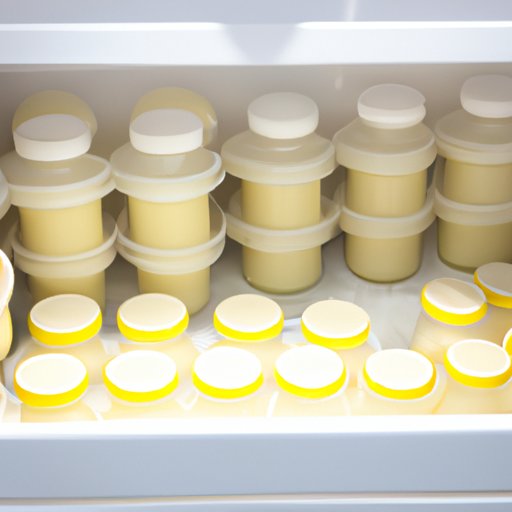
How Long Can You Keep Breast Milk in the Fridge?
Breast milk is the best source of nutrition for infants, and many mothers prefer to pump and store it for later use. However, it’s essential to store breast milk properly to maintain its quality and ensure safety. One of the most common ways to store breast milk is in the fridge, but how long can you keep it there? In this article, we will provide helpful tips and guidelines for safely storing breast milk in the fridge.
Understanding the Basics of Breast Milk Storage
The guidelines for breast milk storage recommend storing it at a temperature of 32-39°F (0-4°C) in clean and food-safe containers. According to the Centers for Disease Control and Prevention (CDC), freshly expressed breast milk can be stored in the fridge for up to four days. However, it’s essential to remember that temperature and hygiene play a crucial role in determining the shelf life of breast milk.
Factors that can influence the shelf life of breast milk in the fridge include temperature fluctuations, contamination, and improper storage containers. To minimize the risk of spoilage and bacterial growth, it’s recommended to store breast milk at the back of the fridge, where the temperature is most consistent, and to wash your hands and clean the storage containers thoroughly before use.
Recommended Timeline for Storing Breast Milk in the Fridge
The following is a guide to storing breast milk safely in the fridge:
- Freshly expressed breast milk can be stored in the fridge for up to four days.
- Refrigerated breast milk that was previously frozen can be stored in the fridge for up to 24 hours.
- Once you remove breast milk from the fridge and warm it up, you should use it within two hours to avoid bacterial growth.
To organize your fridge for optimal storage, you can use clear containers to make it easier to see the milk and label them with the date and time of expression. Make sure to use the oldest milk first and check for any expired milk before feeding your baby.
Tips for Maximizing Shelf Life
To maximize the shelf life of breast milk stored in the fridge, it’s essential to maintain proper temperature control. While the ideal fridge temperature is 32-39°F (0-4°C), it’s crucial to avoid temperature fluctuations by keeping the door closed as much as possible and not overloading the fridge.
Using food-safe storage containers, such as glass or hard plastic, can also help extend the shelf life of breast milk. Avoid using soft plastic bags or containers that may leak or contaminate the milk, and make sure to sterilize the storage containers before use.
Common Myths Debunked
There are many myths and misconceptions about how long breast milk can last in the fridge and what factors can influence its shelf life. One common myth is that breast milk always smells or tastes bad when it has gone bad, but this is not always the case. Spoiled breast milk may also have an unusual texture or appearance, and it can be dangerous to consume even if it smells or tastes fine.
Scientific evidence shows that breast milk is a complex fluid that can have different expiration times, depending on factors such as the amount of bacteria present, storage temperature, and storage conditions. Understanding these factors can help parents safely store breast milk and avoid any health risks.
How to Tell if Milk has Gone Bad
It’s crucial to know how to identify the warning signs of spoiled breast milk to avoid any health risks to your baby. Some of the signs that breast milk may have gone bad include:
- Off or rancid smell or taste
- Sticky or stringy texture
- Unusual color or appearance
- Growth of bacteria or mold
If you suspect that your breast milk has gone bad, do not feed it to your baby. Instead, dispose of it and clean the storage container thoroughly before use.
Alternatives to Fridge Storage
For parents who cannot store breast milk in the fridge for an extended period, other ways to keep it fresh include using a cooler or storing it in a deep freezer. When using a cooler, make sure to pack it with ice packs to maintain the milk’s temperature, and limit the storage time to no more than 24 hours. When storing breast milk in a deep freezer, you can store it for up to 12 months, but make sure to use the oldest milk first.
When traveling or away from home, you can also use insulated bags with ice packs or bottles of frozen water to keep the milk cool. Make sure to pack the milk in a leak-proof container, and avoid exposing it to direct sunlight or extreme temperatures.
Troubleshooting Common Issues
Parents may encounter common problems when storing breast milk in the fridge, such as power outages, temperature fluctuations, and difficulty thawing frozen milk. To avoid these issues, it’s recommended to have a backup power source, such as a generator or battery backup, and to check the fridge temperature regularly.
If you need to thaw frozen breast milk, you can do so by placing it in the fridge overnight or running it under warm water. Avoid using a microwave or boiling water to thaw breast milk, as this can destroy its nutrients and decrease its quality.
Conclusion
Storing breast milk in the fridge is an easy and convenient way to have a ready supply of milk for your baby. However, it’s essential to follow the guidelines and tips discussed in this article to ensure the safety and quality of stored breast milk. By maintaining proper hygiene, temperature control, and storage containers, parents can provide their infants with safe and nutritious breast milk for as long as possible.





